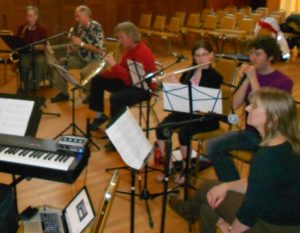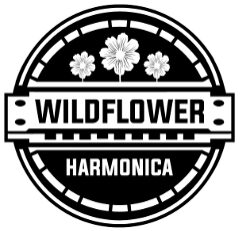Originally posted Nov 2014
 I’m playing diatonic harmonica in an Early Jazz ensemble at the Vermont Jazz Center right now, and part of the fun is looking in my harp case at the 12 different keys and deciding which one best fits the song.
I’m playing diatonic harmonica in an Early Jazz ensemble at the Vermont Jazz Center right now, and part of the fun is looking in my harp case at the 12 different keys and deciding which one best fits the song.
Or rather, that WOULD be fun, if I had multiple harps that were properly set up for overblows.
Right now, however, my C harp is it. Especially since I have to do a lot of reading for this band.
So I’ve been playing everything on one diatonic harmonica, pretty much. It’s hard! I’m glad I did a lot of scale homework over the last few years.
We’re playing songs from Louis Armstrong, Sidney Bechet, Fletcher Henderson, Count Basie, and various combos nobody’s heard of, from the 20s and 30s.
Imagine you only have a C harp and you have to play: C blues, F blues, G major and minor, B-flat major, E-flat major, D minor. Some of those keys lay out well because they relate closely to the home key of C. But others, not so much…
On top of the scale work, to really approach anything like hipness, you’ve got to arpeggiate just about every chord in the tune. Over the course of a few songs, that can end up meaning playing in all 12 keys, albeit briefly. Which is a great accomplishment, and I want to get better at all that, but after a month of rehearsals, I figured there must be an easier way.
A few of the melodies required notes that were too low for my C harp, so I spent a couple of evenings working on a new B-flat harp, and boy, what a difference it makes. I’d only expected to get some lower notes, but I knew somewhere in the back of my mind that horns like to play in Bb, F, and Eb.
I seem to have stumbled by accident into the magic “key of jazz.” It might not work out for every song in the world, but for the setlist I’m working on, sure enough, using a B-flat harp, half my songs are now playable in 1st, 2nd and 3rd position. And the other half are possible using the same easy positions on a C harp.
Yes, overblows are still necessary, and yes, bending accurately on holes 2 and 3 is always a challenge. Keeping track of where you are as you switch positions to follow the chords is still a lot of mental math.
But using a B-flat harp on these songs puts those changes in slightly easlier positions (for me, at least). It’s a real relief. Here’s hoping that now that the “good notes” are more easily accessible, I can focus my mojo on making it all swing a little more.
PS: full disclosure, the picture above isn’t from my Vermont jazz class, it’s from an earlier workshop I participated in. But it IS pretty much what our rehearsals look like.
